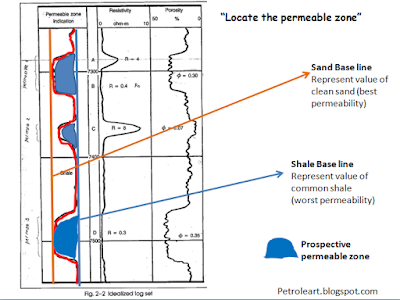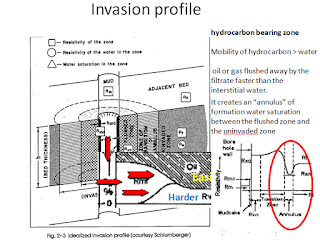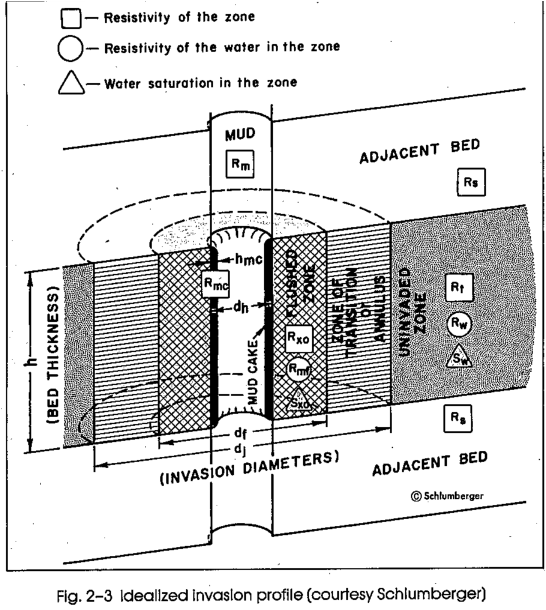Unconventional Reservoir Overview
This post is an elaboration of the "Basic Logging Interpretation" slide which I share in my previous post [CLICK HERE]. This explanation will fit the best if you want to present the "Basic Logging Interpretation" slide at page 6
Basic: Why the Logging
Results Should Show The Permeability?
Because the permeability of the rock represent the capacity
of the rock to flow the fluid through it, it is very common that a wellbore be
checked by logging tools to measure the permeability of some interesting place
of the zone. For more detailed technical and scientific information about
permeability, see my
previous post here. So since a low permeability rock will hardly flow fluid
through them and high permeability rock will flow fluid easily, people will
check the logging result whether they can find high permeability zone with low
resistivity.
So, People Will Look
For High Permeability Zone Which Contains Hydrocarbon!
Exactly! Permeability is usually expressed in millidarcys and
people will commonly look for zones which permeability is about ten to several
hundred millidarcys as the oil reservoir. It will be categorized as
conventional reservoir which procedure, technology, and knowledge have been
widely used. Also the economical return is still profitable to the company.
Unfortunately, the party is over! As oil getting harder and
harder to be searched, people start to consider gas as one of the main power
source. conventional oil resources are estimated to be around 70 billion
barrels, while the conventional natural
gas is about 590 trilion SCF! Gas is cheaper because it is harder to be
handled and less popular, so when the price of oil is getting higher, the price
of gas becomes more interesting than years before.
WAIT, YOU ARE WRONG!
The oil price is lower now than years before!
As I say higher price, it means as supply and demand
relation. That means, as unrenewable energy, the more oil demand now will make
the less supply in the future, and when the demand in the future still high
although we only have few supply, the price will be high. The low oil price now
is the impact of political decision and oversupply from the unconventional gas. We may enjoy the
oversupply now, but when we realize that we have depended on oil and gas too
much, the price may be much higher than before when the supply decrease
abruptly.
So there’s
conventional gas reservoir and unconventional gas reservoir? What is the
definition of unconventional?
Yes there are differences of conventional gas and
unconventional gas. The differences of gas and oil are about the properties of
the fluid, e.g. the percent of methane, the phase of the fluid. In other hand,
conventional and unconventional is all about how easy we may produce handle,
and sell it from its reservoir. So the unconventional oil reservoir will
contain extra heavy oil, bitumen (a little bit solid), or shale oil (oil from
shale, which is hard to flow); while unconventional gas will be about low
quality gas (high percentage of CO2 and sulfur), tight sand gas (low
permeability), and gas hydrates (from the permafrost of ocean)
Why searching
unconventional reservoirs when there are plenty conventional gas reservoirs?
The conventional gas reservoir resources were estimated
around 590 trillion SCF, but it doesn’t mean they are widely spread all over
the world! Arabian countries have a lot of proven reserves in their land that
they could produce oil easily and sell them cheaply. In America, such oil is
very low in number, but they have a lot of gas in their shale, which is tight
in permeability and harder to produce, but the revenue will be very big. It is
very important to depend on every country’s own power source, instead expensively
buy from other countries. Just imagine,
Venezuela would be the largest oil reserves in the world if their 225 billion
barrels of extra heavy oil considered as recoverable.
Back to the picture,
how they could get oil/gas from low permeability zone?
Hydraulic Fracturing (“fracking”) is the technology to
create artificial permeability to the zone. Advances in fracking techniques create
a tremendous increase in shale oil and
gas production. The permeability will be
increased by artificially introducing small fractures into the formation. The
pressure from the fluid used in fracturing will create fracture to the rock.
Additional pressure injected from the surface will make the fluid penetrate
deeper to the formation, and create longer fracture. This fluid contain many “granules”
named proppant which will support the
fracture to stay opened when the pressure released. This way, the permeability
of the zone has been increased.
First Fluid which is at first in hydraulic fracturing is called
"pad". The pressure applied to get the pressure at which the rock break,
called the breakdown pressure. Then fracturing fluids is used to a wide fracture,
wide enough for the proppant to flow in without bridging or settling. That is
why the fracturing fluid should have high viscosity.
Proppant will make high permeability flowing channel into
the well. The permeability contrast between
fracture and the formation will determine the increase in the production of a
fracturing project. The more fracture permeability contrasted with the real
permeability, greater productivity will be gained. But it does not mean that we
always use the biggest proppant,we still look for the most economical way, in
the selection of size and types of proppant. When proppant stressed more than its strength, it will be crushed and
it is a disadvantage in terms of productivity. There are many things could be
used as proppant, such as sand, ceramic, and resin coated proppant.
How about the unconventional
reservoir permeability measurement? Will we use the same log?
We also use log to know the permeability of the reservoir.
But an important complication is there is different resolution between the logs
relative to the heterogeneity often exhibited at the core scale. Core
measurements are often performed on a small sample while the log will represent
the data for feet depth. Some attempt to scale up the core measurements should
be done to allow for calibration of log to core data. Also the problem of the
calibration is the heterogeneity of the zone is very high that scale up might
be hard. These heterogeinity also makes the unconventional reservoir
characterization become harder than the conventional one.
The unconventional reservoir studies are very important
nowadays since it is the future of our energy sources, which is agreed by many
consultants. The unconventional reservoir engineering and training are developing
to create more economic method of production, with the prime safety
consideration. Also, young engineers should enrich themself in unconventional reservoir since it might be the future of world's energy
Do you love this post? Thank you! I feel appreciated. This post is under the category of Petroleum Engineering, you may love to see other similar posts HERE
Do you love this post? Thank you! I feel appreciated. This post is under the category of Petroleum Engineering, you may love to see other similar posts HERE






Comments
Post a Comment